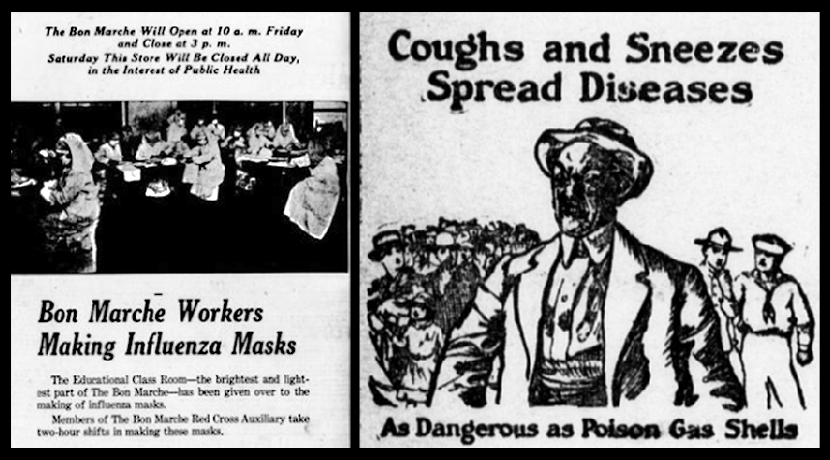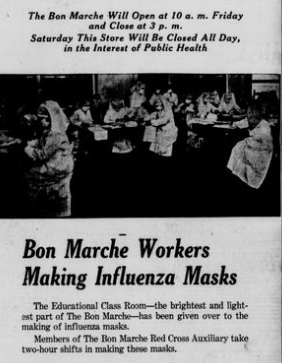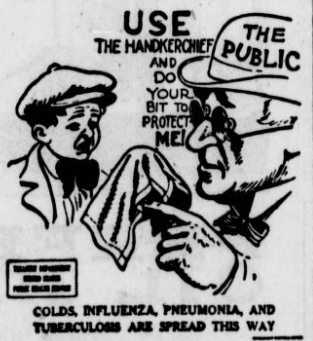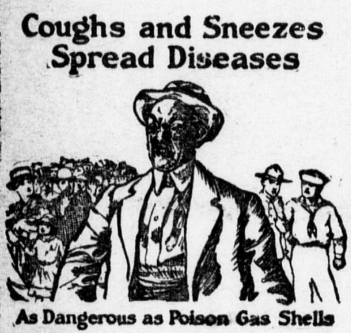
Exploring the 1918 Influenza Pandemic with the State Library’s Digital Collections
In 1918, while Washingtonians were anxiously awaiting for their boys to come home near the end of WWI, reports were coming over from Europe about soldiers dying from a mysterious Spanish Influenza.
Reports of “la grippe,” the “flu,” and “pneumonia,” the epidemic was caused by a strain of Pfeiffer’s Bacillus, named after the epidemiologist who discovered it in 1892. By mid-September, before the war was over, it had reached the shores of Washington and at least 23 other states.
Warnings from federal officials, such as U.S. Surgeon General Dr. Rupert Blue and Army Surgeon General Dr. William Gorgas, were already warning people to wear masks in public, stay away from infected persons, and “if you’re sick – stay home!” in voluntary self-quarantine. In order to identify and contain the disease, U.S. Congressmen Simeon D. Fess (R) and Henry I. Emerson (R) requested a $5,000,000 appropriation to fund the research suggested by the American Medical Association and prevent higher costs to tax payers in the future, though their efforts were delayed in the House vote (see As the Flu Peril Nears).
By early October Seattle’s Mayor Ole Hanson ordered closures of businesses and schools to check the fast spread across the city. City health officials began requiring stricter quarantines. Physicians were ordered to submit patient lists so notices could be posted on quarantined homes with the clear warning: “Influenza.”

At the same time, community efforts were growing to help with prevention. Some businesses, such as the Bon Marche department store, were utilizing their Bon Marche Red Cross Auxiliary members to sew masks “under the most sanitary conditions” for people to wear in public (see Bon Marche Workers Making Influenza Masks).
Reports from the east side of the state were also showing evidence of the spread to the smallest, most vulnerable communities with limited access to doctors. An example being a barber who infected 12 of his customers in the small town of Molson, Washington, after he returned from a visit to Seattle (“Spanish Influenza” “Three Day Fever “– “The Flu”).
Over the next few months, communities across the state would struggle with whether to keep up with recommended quarantines or stay open for business and public events. By December 6, 1919, Tacoma saw 30 new cases within a 36-hour period, 24 of which were students at the Annie Wright Seminary returning after the Thanksgiving holidays.
Spokane had 362 cases with eight deaths and were deciding on whether to impose a general quarantine. A week later, Pullman Herald editor, William Goodyear, scolded the city of Spokane in response to a large public gathering held for their Peace Celebration event which led to another flare up of flu cases (Pure Camouflage).
Though WWI ended in November, soldiers returning from Europe were finding high rates of influenza in their own military camps and at home. The following January, the Seattle Star reported that the “Flu Killed more Americans this fall than were killed in all the American battles with Germany” (Great Menace) though by that time Congress still had not approved the appropriation needed for research requested by the medical community.
Many plans and events were cancelled due to either quarantine or illness, including the world hockey championship where Seattle had a chance to make its mark in the world of sports. Five Canadian Hockey players fell ill to influenza right before the “deciding game of the world’s puck classic” which was to be hosted by the Seattle Metropolitans, three of whom were also down with the flu (Big World Contest is Deferred).
Barely over 100 years later, is history repeating itself? Does any of this sound familiar? A review of online articles shows that people had many of the same questions we do today: “How do I prevent this and keep my family safe?” “Can I catch it again?” “How does it spread?” As you read through some of these newspaper articles many answers may also sound familiar.

“Use your Handkerchief” illustration reminds people to turn away from coughs and sneezes. 
Public service announcement used across the country in many newspapers during the Spanish Influenza.
The “Use your Handkerchief” illustration reminds people to protect others and turn away from coughs and sneezes. In Cayton’s Weekly a list from Surgeon General Blue has great advice for physicians including comments about infection through “droplets,” isolation of infected patients, avoiding crowds, and encouraging “Education as regards the danger of promiscuous coughing and spitting.” His colleague Dr. Gorgas recommends eight points to avoid contagion, the last of which, but not the least, “#8. Your fate may be in your own hands; wash your hands before eating.”
The Seattle star. (Seattle, Wash.), 26 Sept. 1919. Chronicling America: Historic American Newspapers. Lib. of Congress. <https://chroniclingamerica.loc.gov/lccn/sn87093407/1919-09-26/ed-1/seq-6/>
Public Should Prepare to Resist Influenza
The Colville examiner. (Colville, Wash.), 27 Sept. 1919. Chronicling America: Historic American Newspapers. Lib. of Congress. <https://chroniclingamerica.loc.gov/lccn/sn88085318/1919-09-27/ed-1/seq-8/>
Mayor Closes Theatres, Schools and Churches (Hanson)
The Seattle star. (Seattle, Wash.), 05 Oct. 1918. Chronicling America: Historic American Newspapers. Lib. of Congress. <https://chroniclingamerica.loc.gov/lccn/sn87093407/1918-10-05/ed-1/seq-1/>
What Do You Know about Spanish Flu?
Uncle Sam’s Health Experts Tell How to Handle Disease if it Hits Your Family
The Seattle star. (Seattle, Wash.), 11 Oct. 1918. Chronicling America: Historic American Newspapers. Lib. of Congress. <https://chroniclingamerica.loc.gov/lccn/sn87093407/1918-10-11/ed-1/seq-9/>
How to Fight Spanish Influenza
Shared article from the Literary Digest. Surgeon General of the U.S. Army issued 8 recommendations for the avoidance of contagion. Surgeon General Rupert Blue issued a special bulletin for physicians.
Cayton’s weekly. (Seattle, Wash.), 12 Oct. 1918. Chronicling America: Historic American Newspapers. Lib. of Congress. <https://chroniclingamerica.loc.gov/lccn/sn87093353/1918-10-12/ed-1/seq-4/>
“Spanish Influenza” “Three Day Fever “– “The Flu”
Influenza at Molson
“Nurses and attendants do well to guard against breathing in dangerous disease germs by wearing a simple fold of gauze or mask while near the patient.” Barber who visited Seattle brought flu to 12 customers in the tiny town of Molson, Washington.
The Oroville weekly gazette. (Oroville, Wash.), 18 Oct. 1918. Chronicling America: Historic American Newspapers. Lib. of Congress. <https://chroniclingamerica.loc.gov/lccn/sn88085101/1918-10-18/ed-1/seq-1/>
Bon Marche Workers Making Influenza Masks and continued – Mayor Hanson Closes Stores to Check “Flu”
Seattle closes businesses while some cities across the country are ready to start lifting ban, even after 268 deaths and 555 new cases reported in one day in Chicago.
The Seattle star. (Seattle, Wash.), 31 Oct. 1918. Chronicling America: Historic American Newspapers. Lib. of Congress. <https://chroniclingamerica.loc.gov/lccn/sn87093407/1918-10-31/ed-1/seq-10/>
Seattle Star Weekly News Letter for Men in Service
Summary of week’s news including impact of flu on businesses
The Seattle star. (Seattle, Wash.), 02 Nov. 1918. Chronicling America: Historic American Newspapers. Lib. of Congress. <https://chroniclingamerica.loc.gov/lccn/sn87093407/1918-11-02/ed-1/seq-1/>
Influenza Ban in Lynden Lifted When War Closes
…following order by State Health Commissioner Thomas D. Tuttle after a similar lift on restrictions by Bellingham
The Lynden tribune. (Lynden, Wash.), 14 Nov. 1918. Chronicling America: Historic American Newspapers. Lib. of Congress. <https://chroniclingamerica.loc.gov/lccn/sn88085445/1918-11-14/ed-1/seq-3/>
Quarantine is Lifted & School will Open Monday Morning
Pullman herald. [volume] (Pullman, W.T. [Wash.]), 15 Nov. 1918. Chronicling America: Historic American Newspapers. Lib. of Congress. <https://chroniclingamerica.loc.gov/lccn/sn88085488/1918-11-15/ed-1/seq-1/>
Use your Handkerchief – illustration
The Lynden tribune. (Lynden, Wash.) 1908-current, December 05, 1918, Image 2
Image provided by Washington State Library; Olympia, WA
Persistent link: https://chroniclingamerica.loc.gov/lccn/sn88085445/1918-12-05/ed-1/seq-2/
Flu Cards Nailed on Seattle Homes
The Seattle star. (Seattle, Wash.), 06 Dec. 1918. Chronicling America: Historic American Newspapers. Lib. of Congress. <https://chroniclingamerica.loc.gov/lccn/sn87093407/1918-12-06/ed-1/seq-1/>
County Health Officer Says Take Precautions
Dr. Clark observes improvements after four weeks of quarantine and provides sound advice all too familiar over 100 years later.
The Colville examiner. (Colville, Wash.), 07 Dec. 1918. Chronicling America: Historic American Newspapers. Lib. of Congress. <https://chroniclingamerica.loc.gov/lccn/sn88085318/1918-12-07/ed-1/seq-2/>
Flu Won’t Come Back: Sporadic Cases not Epidemic
“Dr. Blue doesn’t believe there will be this winter another such general visitation as that which has exacted a toll of 330,000 civilian and 20,000 soldier and sailor lives in this country.”
The Seattle star. (Seattle, Wash.), 11 Dec. 1918. Chronicling America: Historic American Newspapers. Lib. of Congress. <https://chroniclingamerica.loc.gov/lccn/sn87093407/1918-12-11/ed-1/seq-1/>
“Health officials and businesses struggled between quarantine and being open for business” – comment by editor Wm. Goodyear in response to Spokane’s Peace Celebration leading to another flare up of flu cases.
Pullman herald. [volume] (Pullman, W.T. [Wash.]), 13 Dec. 1918. Chronicling America: Historic American Newspapers. Lib. of Congress. <https://chroniclingamerica.loc.gov/lccn/sn88085488/1918-12-13/ed-1/seq-4/>
Our Greatest Menace: Money Spent Now to Fight the Dreaded Disease Will Prevent Great Loss of Life
“Flu Killed more Americans this fall than were killed in all the American battles with Germany”
The Seattle star. (Seattle, Wash.), 27 Jan. 1919. Chronicling America: Historic American Newspapers. Lib. of Congress. <https://chroniclingamerica.loc.gov/lccn/sn87093407/1919-01-27/ed-1/seq-6/>
Five Canadian Hockey players fell ill to influenza right before the “deciding game of the world’s puck classic” to be hosted by the Seattle Metropolitans, three of which were also down with the flu.
The Seattle star. (Seattle, Wash.), 01 April 1919. Chronicling America: Historic American Newspapers. Lib. of Congress. <https://chroniclingamerica.loc.gov/lccn/sn87093407/1919-04-01/ed-1/seq-1/>
Considerations a year later from Journal of the American Medical Association.
Pullman herald. [volume] (Pullman, W.T. [Wash.]), 31 Oct. 1919. Chronicling America: Historic American Newspapers. Lib. of Congress. <https://chroniclingamerica.loc.gov/lccn/sn88085488/1919-10-31/ed-1/seq-4/>